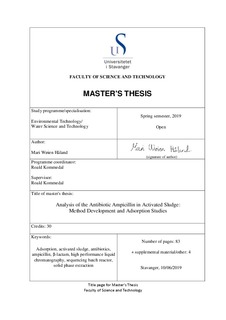Analysis of the Antibiotic Ampicillin in Activated Sludge: Method Development and Adsorption Studies
Master thesis
Permanent lenke
http://hdl.handle.net/11250/2623658Utgivelsesdato
2019-06Metadata
Vis full innførselSamlinger
Sammendrag
The presence of antibiotics in wastewater treatment plants is a concern, both because of potential release to natural water systems, and connected to the spread of antibiotic resistance genes. In this thesis, the focus is on the β-lactam antibiotic ampicillin in activated sludge.
A method for analysing ampicillin in wastewater samples was found in literature, adapted, and tested using concentrations in the 0.050-1.0 mg/L range. Key steps in the method are sample preparation by solid phase extraction (SPE), and analysis by high performance liquid chromatography (HPLC) with UV-detection. Automated SPE by a RapidTrace® instrument was employed. β-lactam antibiotics cloxacillin and dicloxacillin were used as internal standards.
When applied, the method measured ampicillin concentrations down to 10 μg/L. Recovery from SPE on wastewater effluent samples was found to be 75% or greater, with high precision. A version of the method for larger sample sizes proved time-consuming.
The developed method was used to study the fate of ampicillin in activated sludge, with a focus on adsorption. This included measuring removal over time and an attempt at equilibrium modelling using Freundlich and Langmuir adsorption isotherms. The results from these studies were largely inconclusive. However, removal of ampicillin in the sludge was found to be high, for 1-3 g/L mixed liquor suspended solids (MLSS). Some of the removal was shown to be due to chemical degradation.
Beskrivelse
Master's thesis in Environmental engineering

